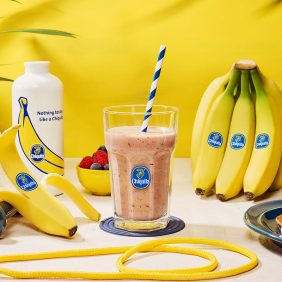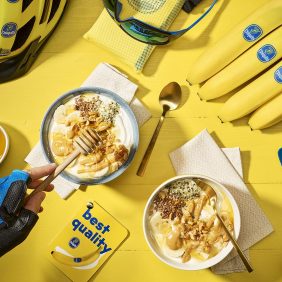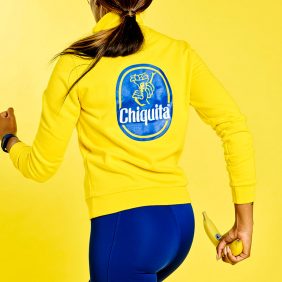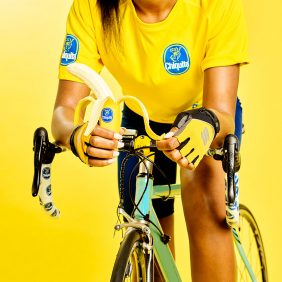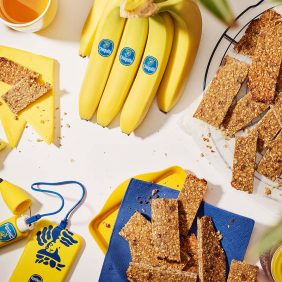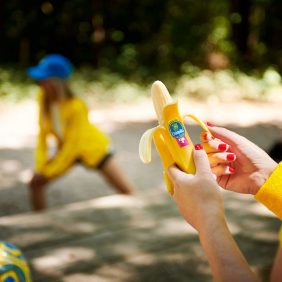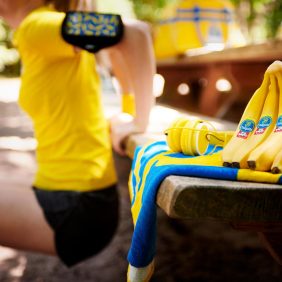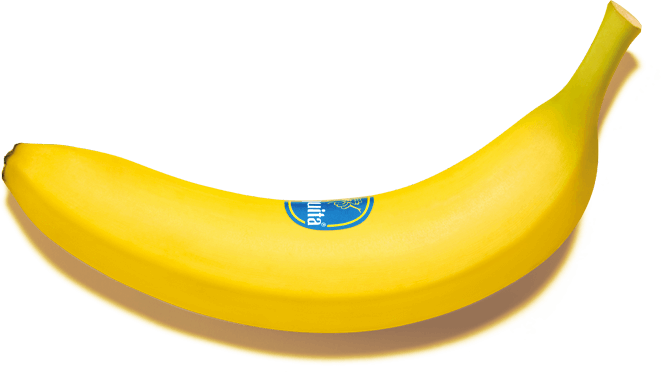Are you ready for the New York City Marathon?
Get ready for the New York City Marathon with these simple tips from Frankie Ruiz, certified Nike© Run Club coach and co-founder of the Miami Marathon. He share with us the best practices to train and what to eat for energy needed to run a marathon.

16-Week Full Marathon Training Plan with Frankie Ruiz
Keeping it simple
The single most important rule for runners preparing is to know what to eat for energy for a big race, do not try any new foods or diet routines that you haven’t tried before. Keep things simple and stick with foods you know your body does well with. If you are more than 5 days out from a race, you can run a few trials of what foods work best for your body. Focus on breakfast and dinner, as those two meals will be the most important to your morning race.
Carb-Load a Few Days Out
Don’t wait until the night before to start your carb loading. Start your in-take 72 hours from your race time. Your percentage of calories coming from carbs should start to increase to a point where carbs are 80% of your meals. You want to bring in the carbs to increase your glycogen stores which provide energy to your muscles. To help accomplish this, you should decrease the amount of training as you taper your workouts for the race. And if you’re asking yourself, “what to eat before running”, bananas are an excellent choice.
Snacks – Banana Nutrition is Essential for Runners
It’s important to prepare your snacks and what to eat before running, by trying out what snacks work best beforehand. A snack time that works for many runners is the time between breakfast and the race. This could be the time spent in transport to the race or while waiting in your corral. One of the best benefits of bananas is how convenient they are making them one of the greatest workout snacks. They’re packed with all the good natural sugars, fiber, and loads of essential vitamins and minerals like potassium and magnesium, for a slow energy release. And best of all, they’re easy to take with you!
Recovery During and After
For the last few workouts leading up to your marathon you’ll want to focus on recovery. Recovery should include treating your body to the right fuel during and immediately after your runs. If you are training in humid conditions, you’ll want to make sure you stay hydrated which means having electrolyte replenishment drinks along the way. After the run, you’ll want to replenish the body with something nutritious – maybe a healthy banana smoothie or energy bar that has a good balance of carbs and protein.
Practice eating on the run
The time spent running a marathon can be a long time, and your body needs to constantly restore glycogen to keep you from ‘hitting the wall’ and slowing down. That wall tends to hit us around the mile 20 mark. Bananas are truly the best workout snacks and the good news is – most marathons provide gels and Chiquita bananas along the way. You can always pack your own healthy snacks as well – something light and easy to digest.

16-Week Full Marathon Training Plan With Frankie Ruiz
Are you ready to take on the full marathon distance (26.2 miles/42 KM)?
Frankie Ruiz is a certified Nike© Run Club coach and co-founder of the Miami Marathon. He has built numerous training and recovery plans to help you reach your fitness goals.
So… you’ve already crushed your half marathon goal and now you have your heart set on doubling the distance in the crown jewel of running events – the Full Marathon! You’ve planned your race calendar and can use some experienced guidance to get that finisher’s prize. This plan will help properly prepare your entire body using a variety of running workouts – combined with the Chiquita Fitness Stickers Challenge Exercises – so that you can enjoy your experience.
Below you’ll find our 16 Week Marathon Training Plan, however, depending on your current fitness level, this plan can vary by a few weeks. When beginning the training program, you’re encouraged to be in shape to complete at least a 10K. If you’re not, please add 4 to 6 weeks to the schedule by spending an additional two weeks on Weeks 1 through Week 3. If you’re in good enough shape to complete a 10K today, then you can follow the weeks from start to finish.
Bucket List or Competitive
If you’re looking to just complete the race in your own time and have some fun, this schedule can work for you too. If you’re a more seasoned runner and are looking to PR or compete, you should follow the plan, however, try to add more intensity and adjust your total volume accordingly.
Running is simple. So why all the technical terms?
Running jargon can be a bit confusing and in many cases different terms mean different things to different runners. To get the best understanding before you dive into the training, take a few moments to review some of the terminology described below.
Your training will primarily include the following 5 types of runs. And within these assigned runs, you’ll be running at different speeds and maintaining certain paces.
Workouts
• Tempo Runs
• Intervals
• Long Runs
• Fartlek
• Striders
• Recovery
Tempo Runs
This type of workout, also called quality running, is best described as sustained speed for a predetermined duration – usually no longer than 40 minutes or so. This is a pace where a conversation with your running mate isn’t really easy or even possible. At this pace, you aren’t too comfortable but you can still handle the pace steadily for a longer period of time.
Intervals
This type of workout is usually done on a track or an unimpeded leveled path. The idea here is that you will run fast but for short distance bouts with rest between each repetition. Your form and strength will gain the most from this type of workout. Think shorter distances but higher intensity.
Long Runs
This is the one element of training for a marathon you can’t live without. As the name suggests, it’s a longer run and the pace held is usually conversational and comfortable. They can be longer durations but lower in intensity. This is a distance we slowly progress to so that we can eventually come close to that coveted 26.2 mile / 42 km distance. The physical gains are tremendous, but equally important, is the confidence you’ll build as you complete the increased distance each week. This is where the endurance is built so you slowly build to push forth when you feel you can’t – and the next time that moment comes even later.
Fartlek
This is a Swedish term for speed-play. When this is assigned it means you will vary your speed within the run and use slower speeds to recover for allotted specific time.
Striders
Striders are not a sprint – but close to one! They’re about 10-20 seconds long and they’re good for form and to promote an efficient stride. The pace for these is usually a gradual build up to almost a sprint. This is a good time to run like the cameras are on you! You’ll want to pay extra attention to your posture, your arm swing and your leg turnover. Striders will be one of the more frequently assigned elements to your training.
Recovery
This is crucial for every athlete on the full marathon training plan. The lowered intensity and reduced volume is important to give the body time to repair. The greatest gains of the body and mind will come during these recovery days, during which you should still try to do some light exercises from the Chiquita Fitness Stickers Program. This helps to train the entire body as an overall athlete and not just a runner. You can also use the recovery days to substitute the running for other exercise such as cycling, swimming or other cardio activity. If you are experiencing any kind of pain lasting more than 24 hours, consider adjusting the schedule, intensity or simply take a day off. It is better to get to race day slightly under trained and without injury. General muscle and joint soreness is part of the journey but with proper nutrition, consistent rest and recovery exercises you’ll do just great!
Week “0”
Before you start any full marathon training plan, make sure you check with your doctor that you’re cleared to start training. Next, make sure you are all geared up by visiting a running store. You should also have a distance and time recording device. That device can be a wearable GPS-enabled watch or other smart watch. You can also take your smart phone with you and download any of the many running apps available.
Warm-ups
Before each run, you should do a warm-up routine of about 10-15 minutes. Your routine can be a mixture of jogging followed by some dynamic movement. Some of the best dynamic exercises can be found on the Chiquita Fitness Stickers. The 20 Jumping Jacks, 30 High Knee Taps and 20 Deep Lunges are a great set to repeat a few times to get the body ready to go.
Cool-Down
The cool-down movements done after the assigned workout is completed include more static stretches which are like holding yoga poses for 20-30 seconds. The routine for this should also last 10-15 minutes. This is also a good time to end your entire workout with the Ten Minutes of Mindfulness from the Chiquita Fitness Challenge Sticker. Spend those ten minutes reflecting on your recent run and workout. Try to find moments where you felt yourself overcoming some of the more difficult parts of the workout. Visualize your next workout and run through a scenario that includes you successfully completing the race ahead.
Your Journey
Alright, let’s get this show on the road! We know that the race is the focus but the fun and the positive life impact is in the training itself. You can move the workouts around during the week but don’t do any of the workout days back to back. Make sure to insert a recovery day or rest day in between. Keep in mind that recovery always means we are still doing something. The word rest means you do no exercise that day.
And don’t forget to include bananas as your go-to workout snacks! Banana nutrition is essential for runners, like you, to get that boost of long lasting energy you need for training and races.
